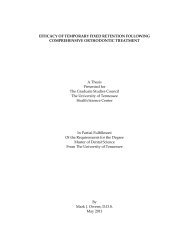Samina Asad Taherbhoy Abstract - ETD Index Page
Samina Asad Taherbhoy Abstract - ETD Index Page
Samina Asad Taherbhoy Abstract - ETD Index Page
Create successful ePaper yourself
Turn your PDF publications into a flip-book with our unique Google optimized e-Paper software.
<strong>Samina</strong> <strong>Asad</strong> <strong>Taherbhoy</strong><br />
Document Type:<br />
Name:<br />
Email Address:<br />
Title:<br />
Degree:<br />
Major:<br />
Program:<br />
Track, if Integrated Program in Biomedical<br />
Sciences:<br />
Research Advisor:<br />
Advisor's Email:<br />
Committee Members:<br />
Keywords:<br />
Availability:<br />
Doctoral Dissertation<br />
<strong>Samina</strong> <strong>Asad</strong> <strong>Taherbhoy</strong><br />
samina.taherbhoy@gmail.com<br />
Neural Systems for Reading in Childhood<br />
Medulloblastoma Survivors – An fMRI Study<br />
Doctor of Philosophy<br />
Biomedical Sciences<br />
Integrated Program in Biomedical Sciences<br />
Neuroscience<br />
Robert J. Ogg, Ph.D.<br />
robert.ogg@stjude.org<br />
Detlef Heck, Ph.D.<br />
Chia-Ho Hua, Ph.D.<br />
Graduation Date: May 2013<br />
Richard J. Smeyne, Ph.D.<br />
Stephen White, DPhil<br />
DCM, fMRI, Implicit reading,<br />
Medulloblastoma, Orthographic, Phonologic<br />
Embargoed for 12 months<br />
<strong>Abstract</strong><br />
Medulloblastoma is the most common malignant brain tumor in children that occurs in<br />
the cerebellum. Survival rates exceeding 75% are achieved with current treatment protocols,<br />
which involve maximum surgical resection, craniospinal irradiation with or without<br />
chemotherapy. Unfortunately, the majority of these survivors face life-long learning problems<br />
and diminished IQ levels. A body of evidence suggests that disturbances in brain function,<br />
including reading, may be related to a radiation insult to otherwise healthy nervous tissue.<br />
Processing orthographic information takes place in the ventral visual system, which includes<br />
brain areas exposed to high radiation dose due to close proximity to the tumor location.<br />
Therefore, we hypothesized that radiation therapy causes disruption in the maturation of the
ain networks involved in reading. In order to compare how the brain networks of these cancer<br />
survivors differ from the normal healthy controls, we studied these participants at varied time<br />
points – right from start of therapy to end of therapy and 1 year follow-up in the patients as well<br />
as baseline and 1 year after baseline for the controls. We used functional magnetic resonance<br />
imaging (fMRI), a non-invasive technique, to explore which brain regions respond to<br />
orthographic-phonologic processing and implicit reading. We evaluated the hemispheric<br />
lateralization of the function and used dynamic causal modeling (DCM) to determine the<br />
effective connectivity between regions of the ventral visual pathway. There was a decline in<br />
overall brain activation in medulloblastoma patients after therapy and a shift from left<br />
hemisphere dominance to a more bilateral pattern of activation. The effective connectivity<br />
between regions involved in the reading process changed after therapy, with evidence of<br />
increased dorsal visual pathway involvement to compensate for disrupted connectivity from<br />
ventral visual areas to inferior frontal language areas. The functional imaging results support our<br />
hypothesis of treatment-induced disruption of neural systems for reading. This research has<br />
advanced understanding of the adverse effects of cancer therapy on brain function in children.<br />
Functional neuroimaging will help identify potential targets for pharmacological and behavioral<br />
interventions to improve cognitive function in cancer survivors who have already been treated,<br />
and discover opportunities to reduce the negative effects of cancer therapy on patients treated in<br />
the future.<br />
Attached File(s)<br />
pdf (10.4 Mbytes). This pdf best viewed using the latest version of Acrobat Reader. .<br />
| Back to <strong>ETD</strong> <strong>Index</strong> <strong>Page</strong> | Back to CGHS Home <strong>Page</strong> |<br />
Revised 20 May 2013
















